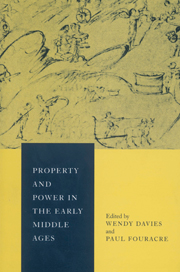Book contents
- Frontmatter
- Contents
- List of maps
- Preface
- List of abbreviations
- Introduction
- 1 The ideology of sharing: apostolic community and ecclesiastical property in the early middle ages
- 2 Teutsind, Witlaic and the history of Merovingian precaria
- 3 Eternal light and earthly needs: practical aspects of the development of Frankish immunities
- 4 The wary widow
- 5 Lordship and justice in the early English kingdom: Oswaldslow revisited
- 6 Adding insult to injury: power, property and immunities in early medieval Wales
- 7 Property transactions and social relations between rulers, bishops and nobles in early eleventh-century Saxony: the evidence of the Vita Meinwerci
- 8 Monastic exemptions in tenth- and eleventh-century Byzantium
- 9 Property ownership and signorial power in twelfth-century Tuscany
- 10 Conclusion: property and power in early medieval Europe
- Glossary
- List of works cited
- Index
7 - Property transactions and social relations between rulers, bishops and nobles in early eleventh-century Saxony: the evidence of the Vita Meinwerci
Published online by Cambridge University Press: 25 January 2010
- Frontmatter
- Contents
- List of maps
- Preface
- List of abbreviations
- Introduction
- 1 The ideology of sharing: apostolic community and ecclesiastical property in the early middle ages
- 2 Teutsind, Witlaic and the history of Merovingian precaria
- 3 Eternal light and earthly needs: practical aspects of the development of Frankish immunities
- 4 The wary widow
- 5 Lordship and justice in the early English kingdom: Oswaldslow revisited
- 6 Adding insult to injury: power, property and immunities in early medieval Wales
- 7 Property transactions and social relations between rulers, bishops and nobles in early eleventh-century Saxony: the evidence of the Vita Meinwerci
- 8 Monastic exemptions in tenth- and eleventh-century Byzantium
- 9 Property ownership and signorial power in twelfth-century Tuscany
- 10 Conclusion: property and power in early medieval Europe
- Glossary
- List of works cited
- Index
Summary
At some time in the late 1020s a scribe who probably belonged to the Paderborn cathedral chapter made two formless records of a property transaction on a small sheet of parchment:
When the lord bishop Maeginuuerc directed his journey to Rome, he gave to Athulf and Hicila for the inheritance of Hatheburg fifteen talents [pounds] and four mansi [landholdings] with twenty mancipia [slaves or serfs]. Each of them should pay five shekels [shillings] of silver.
When Bishop Meinuuerc came back from Rome, he then again gave to the aforementioned in reconciliation one sable fur coat and ten shillings in coin.
Meinwerk, bishop of Paderborn from 1009 to 1036, was a wellplaced and wealthy aristocrat, related to several important families in north-western Westfalia and lower Lotharingia as well as to Emperor Henry II; before his appointment he had served in the royal chapel under Otto III and Henry II. He owed his appointment not only to this service but also to his wealth: allegedly, his response to being offered the bishopric was to say that he could erect a better one from his own resources, and he was evidently expected by Henry II to use his patrimony to endow his new bishopric, as were a number of his contemporaries.
- Type
- Chapter
- Information
- Property and Power in the Early Middle Ages , pp. 165 - 199Publisher: Cambridge University PressPrint publication year: 1995
- 1
- Cited by



